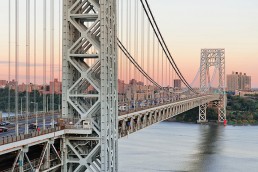Clifton Suspension Bridge 1864
Clifton Suspension Bridge 1864
© Phil Watson
© Sue Martin
Clifton Suspension Bridge
A fitting tribute to Isambard Kingdom Brunel
Key Facts
Two-lane road bridge
Part of the B3129 road
Grade II listed building
Location
Bristol, England
Across the River Avon
Between Clifton (Bristol) and Leigh Woods (North Somerset)
Designers / Engineers
Isambard Kingdom Brunel
John Hawkshaw
William Barlow
Description
Suspension bridge
214.05m main span
412m total length
Main contractors
William Henry Barlow
Construction
Began June 1831
Opened 18 December 1864
The Bridge
Isambard Kingdom Brunel’s first major commission was his appointment, at 24 years old, as project engineer for the Clifton Bridge. He had won a competition to bridge the Avon gorge and designed a grand, landmark suspension bridge as a gateway to the city of Bristol.
There were long delays in its construction and the bridge was not completed until 1864, five years after Brunel’s death. His colleagues at the Institution of Civil Engineers felt that completion of the bridge would be a fitting tribute to Brunel. John Hawkshaw and William Barlow modified the design and oversaw the final construction.
© LouiseDoesLife
Spanning the Avon
The bridge spans 214 metres between its two 26-metre high towers and stands 76m above the river Avon. Modern computer analysis has revealed that in his design of the crucial joints between the 4,200 wrought-iron links that make up the bridge’s chain, Brunel had made an almost perfect calculation of the minimal weight required to maintain maximum strength.
The Clifton Suspension Bridge, as it is now known, has been hailed as one of the most important structures to be built during the Victorian era. It is seen as an icon of engineering ambition and achievement. Although built for pedestrian and horsedrawn traffic, the bridge was so ingeniously constructed that it still provides a safe vehicle and pedestrian crossing over the 76m gorge. It now carries around four million vehicles a year and has become a major route to the motorway network. It is one of Bristol’s cultural icons and provides an easily recognised visual image of the city. It is also symbolic of the city’s history of building bridges between different communities, places and sectors.
© Stocker1970


































































